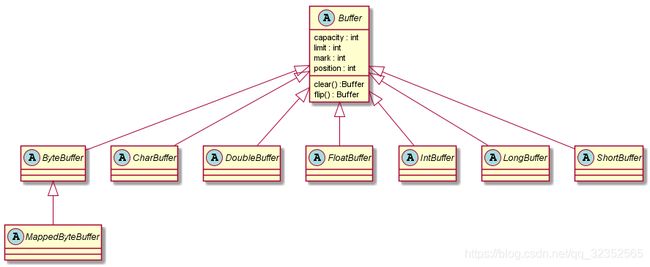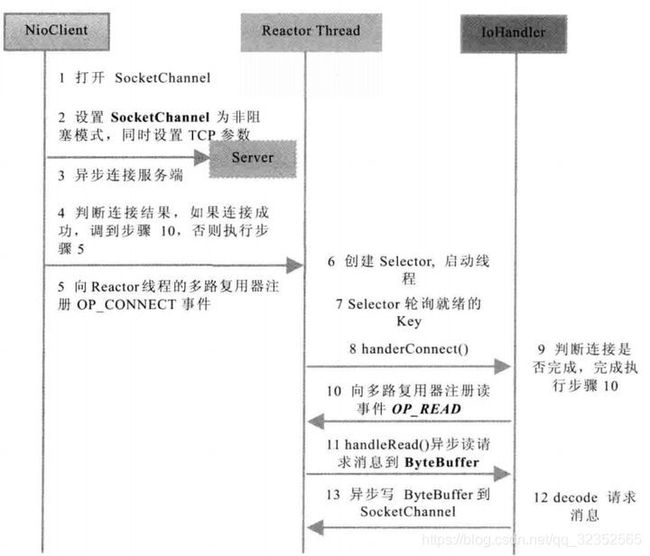Java - I/O 多路复用(NIO)
NIO
NIO,有人解释为new I/O,有人解释为Non-block I/O(我更倾向后者)。
正是由于Java传统BIO的拙劣表现,才使得Java支持非阻塞I/O的呼声日渐高涨,最终,JDK1.4版本提供了新的NIO类库,Java终于也可以支持非阻塞I/O 了。NIO主要的类和接口如下:
- 进行异步I/O操作的缓冲区ByteBuffer等;
- 进行异步I/O操作的管道Pipe;
- 进行各种I/O操作(异步或者同步)的Channel,包括ServerSocketChannel和SocketChannel。
- 多种字符集的编码能力和解码能力;
- 实现非阻塞I/O操作的多路复用器selector:
- 基千流行的Perl实现的正则表达式类库;
- 文件通道FileChannelo。
新的NIO类库的提供,极大地促进了基于Java的异步非阻塞编程的发展和应用,但是,它依然有不完善的地方,特别是对文件系统的处理能力仍显不足,主要问题如下。
- 没有统一的文件属性(例如读写权限);
- API能力比较弱,例如目录的级联创建和递归遍历,往往需要自己实现:
- 底层存储系统的一些高级API无法使用:
- 所有的文件操作都是同步阻塞调用,不支持异步文件读写操作。
2011年7月28日,JDKI.7正式发布。她将原来的NIO类库进行了升级,被称为NIO2.0。它主要提供了如下三个方 面的改进。
- 能够提供能够批量获取文件属性的API,这些API具有平台无关性,不与特定的文件系统相耦合,另外它还提供了标准文件系统的SPI,供各个服务提供商扩展实现;
- 提供AIO功能,支持基于文件的异步I/O操作和针对网络套接字的异步操作;
- 完成JSR-5I定义的通道功能,包括对配置和多播数据报的支持等;
NIO类库概念和功能介绍
缓冲区Buffer
Buffer是一个对象,它包含一些要写入或者要读出的数据。在NIO库中,所有数据都是用缓冲区处理的。在读取数据时,它是直接读到缓冲区中的;在写入数据时,写入到缓冲区中。任何吋候访问NIO中的数据,都是通过缓冲区进行操作。
缓冲区实质上是一个数组。通常它是一个字节数组(ByteBuffer),也可以使用其他种类的数组。但是一个缓冲区不仅仅是一个数组,缓冲区提供了对数据的结构化访问以及维护读写位置(limit)等信息。
最常用的缓冲区是ByteBuffer, 一个ByteBuffer提供了一组功能用于操作byte数组。除了 ByteBuffer,还有其他的一些缓冲区,事实上,每一种Java基本类型(除了 Boolean类型)都对应有一种缓冲区,具体如下。
- ByteBuffer:字节缓冲区
- CharBuffer:字符缓冲区
- ShortBuffer:短整型缓冲K
- IntBuffer:整形缓冲区
- LongBuffer:长整形缓冲区
- FloatBuffer:浮点型缓冲区
- DoubleBuffer: 双精度浮点型缓冲区
每—个Buffer类都是Buffer接口的一个T实例。除了 ByteBuffer,每一个Buffe类都有完全一样的操作,只是它们所处理的数据类型不一样。因为大多数标准I/O操作都使用ByteBuffer,所以它除了具有一般缓冲区的操作之外还提供一些特有的操作,方便网络读写。
管道channel
Channel是一个通道,可以通过它读取和写入数据,它就像自来水管一样,网络数据通过Channel读取和写入。通道与流的不同之处在于通道是双向的,流只是在一个方向上移动(一个流必须是InputStream或者OutputStream的子类),而且通道可以用于读、写或者同时用于读写。
Channel的类继承图如下。
因为Channel是全双工的,所以它可以比流更好地映射底层操作系统的API。特别是在UNIX网络编程模型中,底层操作系统的通道都是全双工的,同时支持读写操作。
多路复用器Selector
多路复用器提供选择已经就绪的任务的能力。 简单来讲, Selector会不断地轮询注册在其上的Channel,如果某个Channel上面有新的TCP 连接接入、 读和写事件, 这个Channel就处于就绪状态, 会被Selector轮询出来, 然后通过SelectionKey可以获取就绪Channel的集合, 进行后续的I/O操作。
使用NIO实现服务端
public class TimeServerNio {
public static void main(String[] args) {
//设置监听端口
int port = 8080;
if (args != null && args.length > 0) {
try {
port = Integer.valueOf(args[0]);
} catch (NumberFormatException e) {
//采用默认值
}
}
//创建了一个被称为MultiplexerTimeServer的多路复用类, 它是个一个独立
//的线程, 负责轮洵多路复用器Selctor,可以处理多个客户端的并发接入
MultiplexerTimeServer timeServer = new MultiplexerTimeServer(port);
new Thread(timeServer, "NIO-MultiplexerTirneServer-001H").start();
}
}
public class MultiplexerTimeServer implements Runnable {
private Selector selector;
private ServerSocketChannel servChannel;
private volatile boolean stop;
/**
* 在构造方法中进行资源初始化, 创建多路复用器Selector、
* ServerSocketChannel,对 Channel 和 TCP 参数进行配置
*
* @param port
*/
public MultiplexerTimeServer(int port) {
try {
selector = Selector.open();
servChannel = ServerSocketChannel.open();
//设置为异步非阻塞模式
servChannel.configureBlocking(false);
servChannel.socket().bind(new InetSocketAddress(port), 1024);
//注册selector
servChannel.register(selector, SelectionKey.OP_ACCEPT);
System.out.println("The time server is start in port : " + port);
} catch (IOException e) {
//资源初始化失败,退出系统
e.printStackTrace();
System.exit(1);
}
}
public void stop() {
this.stop = true;
}
@Override
public void run() {
while (!stop) {
try {
//循环遍历selector,它的休眠时间为1s
selector.select(1000);
//返回就绪状态的Channel的SelectionKey集合
Set selectedKeys = selector.selectedKeys();
Iterator it = selectedKeys.iterator();
SelectionKey key = null;
//通过对就绪状态的Channel集合进行迭代, 可以进行网络的异步读写操作
while (it.hasNext()) {
key = it.next();
it.remove();
try {
handleInput(key);
} catch (Exception e) {
if (key != null) {
key.cancel();
if (key.channel() != null) {
key.channel().close();
}
}
}
}
} catch (Throwable t) {
t.printStackTrace();
}
}
// 多路复用器关闭后,所有注册在上面的Channel和Pipe等资源都会被自动去注册并关闭,所以不需要重复释放资源
if (selector != null) {
try {
selector.close();
} catch (IOException e) {
e.printStackTrace();
}
}
}
private void handleInput(SelectionKey key) throws IOException {
if (key.isValid()) {
// 处理新接入的请求消息
if (key.isAcceptable()) {
// Accept the new connection
ServerSocketChannel ssc = (ServerSocketChannel) key.channel();
SocketChannel sc = ssc.accept();
sc.configureBlocking(false);
// Add the new connection to the selector
sc.register(selector, SelectionKey.OP_READ);
}
if (key.isReadable()) {
// Read the data
SocketChannel sc = (SocketChannel) key.channel();
ByteBuffer readBuffer = ByteBuffer.allocate(1024);
int readBytes = sc.read(readBuffer);
if (readBytes > 0) {
readBuffer.flip();
byte[] bytes = new byte[readBuffer.remaining()];
readBuffer.get(bytes);
String body = new String(bytes, "UTF-8");
System.out.println("The time server receive order : "
+ body);
String currentTime = "QUERY TIME ORDER"
.equalsIgnoreCase(body) ? new java.util.Date(
System.currentTimeMillis()).toString()
: "BAD ORDER";
doWrite(sc, currentTime);
} else if (readBytes < 0) {
// 对端链路关闭
key.cancel();
sc.close();
} else {
; // 读到0字节,忽略
}
}
}
}
/**
* 将应答消息异步发送给客户端
*
* @param channel channel
* @param response response
* @throws IOException exception
*/
private void doWrite(SocketChannel channel, String response)
throws IOException {
if (response != null && response.trim().length() > 0) {
//将字符串编码成字节数组, 根据字节数组的容量创建ByteBuff
byte[] bytes = response.getBytes();
ByteBuffer writeBuffer = ByteBuffer.allocate(bytes.length);
//将字节数据复制到缓冲区
writeBuffer.put(bytes);
writeBuffer.flip();
//将缓冲区中的字节数组发送出去
channel.write(writeBuffer);
}
}
} 使用NIO实现客户端
public class TimeClientNio {
public static void main(String[] args) {
int port = 8080;
if (args != null && args.length > 0) {
try {
port = Integer.valueOf(args[0]);
} catch (NumberFormatException e) {
// 采用默认值
}
}
new Thread(new TimeClientHandle("127.0.0.1", port), "TimeClient-001")
.start();
}
}
public class TimeClientHandle implements Runnable{
private String host;
private int port;
private Selector selector;
private SocketChannel socketChannel;
private volatile boolean stop;
/**
* implements Runnable
*
* @param host host
* @param port port
*/
public TimeClientHandle(String host, int port) {
this.host = host == null ? "127.0.0.1" : host;
this.port = port;
try {
selector = Selector.open();
socketChannel = SocketChannel.open();
//设置为异步非阻塞模式
socketChannel.configureBlocking(false);
} catch (IOException e) {
e.printStackTrace();
System.exit(1);
}
}
@Override
public void run() {
try {
//发送连接请求
doConnect();
} catch (IOException e) {
e.printStackTrace();
System.exit(1);
}
while (!stop) {
try {
selector.select(1000);
Set selectedKeys = selector.selectedKeys();
Iterator it = selectedKeys.iterator();
SelectionKey key = null;
while (it.hasNext()) {
key = it.next();
it.remove();
try {
handleInput(key);
} catch (Exception e) {
if (key != null) {
key.cancel();
if (key.channel() != null)
key.channel().close();
}
}
}
} catch (Exception e) {
e.printStackTrace();
System.exit(1);
}
}
// 多路复用器关闭后,所有注册在上面的Channel和Pipe等资源都会被自动去注册并关闭,所以不需要重复释放资源
if (selector != null){
try {
selector.close();
} catch (IOException e) {
e.printStackTrace();
}
}
}
private void handleInput(SelectionKey key) throws IOException {
if (key.isValid()) {
// 判断是否连接成功
SocketChannel sc = (SocketChannel) key.channel();
//如果返回值为true,说明客户端连接成功
if (key.isConnectable()) {
if (sc.finishConnect()) {
sc.register(selector, SelectionKey.OP_READ);
doWrite(sc);
} else {
System.exit(1);// 连接失败,进程退出
}
}
if (key.isReadable()) {
//预分配1M的接收缓冲K用于读取应答消息, 调川Socketchannel的read()方法进行异步读取操作
ByteBuffer readBuffer = ByteBuffer.allocate(1024);
int readBytes = sc.read(readBuffer);
if (readBytes > 0) {
readBuffer.flip();
byte[] bytes = new byte[readBuffer.remaining()];
readBuffer.get(bytes);
String body = new String(bytes, "UTF-8");
System.out.println("Now is : " + body);
this.stop = true;
} else if (readBytes < 0) {
// 对端链路关闭
key.cancel();
sc.close();
} else
; // 读到0字节,忽略
}
}
}
private void doConnect() throws IOException {
// 如果直接连接成功,则注册到多路复用器上,发送请求消息,读应答
if (socketChannel.connect(new InetSocketAddress(host, port))) {
socketChannel.register(selector, SelectionKey.OP_READ);
doWrite(socketChannel);
} else {
//如果没有直接连接成功, 则说明服务端没有返回TCP握手应答消息, 但这并不代表连接失败, 我们需要将SocketChannel
//注册到多路复用器Selector上, 注册SelectionKey.OP CONNECT»当服务端返回TCP
//syn-ack消息后, Selector就能够轮询到这个SocketChannel处于连接就绪状态
socketChannel.register(selector, SelectionKey.OP_CONNECT);
}
}
private void doWrite(SocketChannel sc) throws IOException {
byte[] req = "QUERY TIME ORDER".getBytes();
ByteBuffer writeBuffer = ByteBuffer.allocate(req.length);
writeBuffer.put(req);
writeBuffer.flip();
sc.write(writeBuffer);
//hasRemaining()方法对发送结果进行判断, 是否全部发送完成
if (!writeBuffer.hasRemaining()) {
System.out.println("Send order 2 server succeed.");
}
}
} NIO编程难度确实比同步阻塞BIO大很多, 上面的NIO 例子并没有考虑“ 半包读” 和“ 半包写” , 如果加上这些, 代码将会更加复杂。
NIO优点总结
- 客户端发起的连接操作是异步的, 可以通过在多路复用器注册OP_CONNECT等待后续结果, 不需要像之前的客户端那样被同步阻塞。
- Socketchannel的读写操作都是异步的, 如果没有可读写的数据它不会同步等待,直接返回, 这样I/O通信线程就可以处理其他的链路, 不需要同步等待这个链路可用。
- 线程模型的优化: 由于JDK的Selector在Linux等主流操作系统上通过epoll实现, 它没有连接句柄数的限制(只受限于操作系统的最大句柄数或者对单个进程的句柄限制), 这意味着一个Selector线程可以同时处理成千上万个客户端连接, 而且性能不会随着客户端的增加而线性下降, 因此, 它非常适合做高性能、 高负载的网络服务器。



